Electronics and Semiconductor Manufacturing in India – A Work in Progress
By Chetan Barapatre, Manager for TMT (Technology, Media, and Telecom) team, Aranca, Growth Advisory unit

Chetan Barapatre
Electronics and semiconductors are vital for operating most devices, machine controls, and vehicles. However, their manufacturing is currently concentrated in a few countries. India is a key part of this industry’s value chain, accounting for 20%[1] of global semiconductor design manpower.
The pandemic-induced supply chain disruptions and global semiconductor shortage forced many nations to contemplate a diversified supply chain and attain manufacturing self-reliance. India’s electronics manufacturing initiatives were also amplified in this period that consequently, attracted investments in the sector.
Electronics Manufacturing in India Under Focus
Manufacturing has been a key focus area for the Government of India (GoI). In recent years, the GoI launched multiple policies, incentives, and schemes to boost production and exports, especially for the rapidly transforming electronics sector.
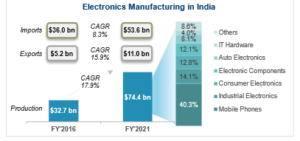 India’s electronics production and exports[2] rose by 2x over the past five years, led by mobile phones (40% share). In 2021, India became the world’s second-largest mobile phone manufacturer by producing 300 mn units. To further boost the sector’s growth wave, the GoI launched an array of incentives to manufacture electronic devices, components, and semiconductors with ambitious targets of developing a $300 bn electronics manufacturing ecosystem and recording exports worth $120 bn by 2026.
India’s electronics production and exports[2] rose by 2x over the past five years, led by mobile phones (40% share). In 2021, India became the world’s second-largest mobile phone manufacturer by producing 300 mn units. To further boost the sector’s growth wave, the GoI launched an array of incentives to manufacture electronic devices, components, and semiconductors with ambitious targets of developing a $300 bn electronics manufacturing ecosystem and recording exports worth $120 bn by 2026.
What Makes Electronics Manufacturing Attractive in India?
- Strong internal capabilities: India offers the advantages of low-cost production, ER&D capability, and abundant manpower to electronics and semiconductor manufacturers. It is home to the largest semiconductor companies, including Intel, AMD, Nvidia, and Samsung, who effectively tapped into these benefits early in the market.
- Changing external environment: India is well-placed to profit from the changing geopolitical environment. The recent government push in the electronics sector is aimed at gaining maximum advantage from the current geopolitical environment while utilizing key areas of internal strength.
- Strong government push: The GoI launched many policies and schemes offering ~$17 bn in fiscal incentives since 2019 to attract companies for creating a domestic manufacturing ecosystem for mobiles, other consumer electronic devices, IT hardware, electronic components, compound semiconductors, silicon photonics, and sensor fab. It also aims to establish semiconductor assembly, testing, marking, and packaging (ATMP); outsourced semiconductor assembly and testing (OSAT); and semiconductor design facilities.

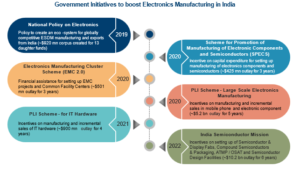
Schemes launched by the GoI encouraged increased participation of global electronics majors. Till date, over 300 domestic and international companies have set up or expanded electronics and component manufacturing facilities.
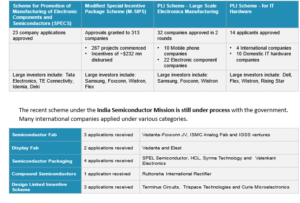

The rise in FDI in electronics manufacturing:
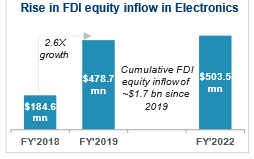 Since the launch of the National Policy on Electronics, FDI in the sector jumped by 2.6x in FY2019.
Since the launch of the National Policy on Electronics, FDI in the sector jumped by 2.6x in FY2019.
Driven by investments from various international corporates, India recorded a cumulative FDI equity inflow of ~$1.7 bn in electronics manufacturing during FY2019–22.
Challenges to Overcome for Success
While the GoI nurtures the electronics and semiconductor manufacturing ecosystem, the sector faces a few challenges, solutions to which would help the industry soar in the next few years.
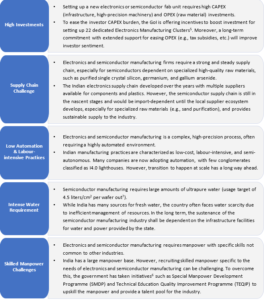
The Journey Ahead
India initiated its evolution from being only a designer of electronics and semiconductors into a manufacturer. Incentives and schemes from the center and states have attracted investor interest leading to the industry developing roots with over 300 domestic and international electronics companies benefiting from GoI schemes and semiconductor fabricators expressing interest in setting up facilities. However, the subsistence of the industry will depend on achieving sustainable operations by overcoming the challenges that lie ahead. Overall, India’s journey to becoming a global manufacturing hub for electronics and semiconductors has begun, but much needs to be done to achieve the goals, and is still a work in progress.
[1] Semiconductor Designing in India
[2] Ministry of Electronics and Information Technology
[3] Electronics Manufacturing Clusters
[4] Manpower Upskilling Programmes
[5] International Technology Roadmap for Semiconductors (2015)












